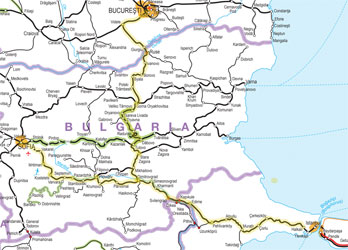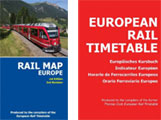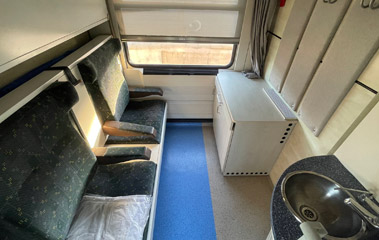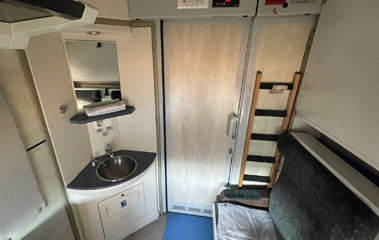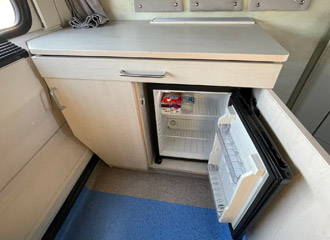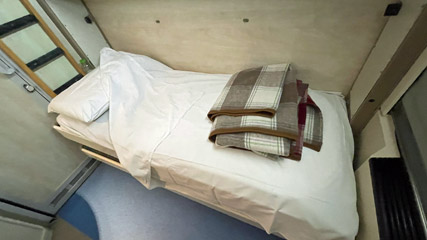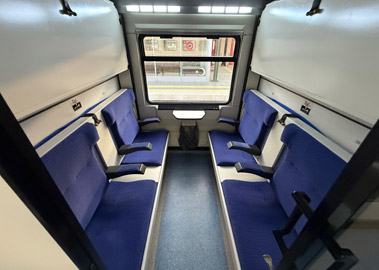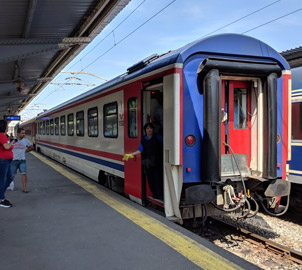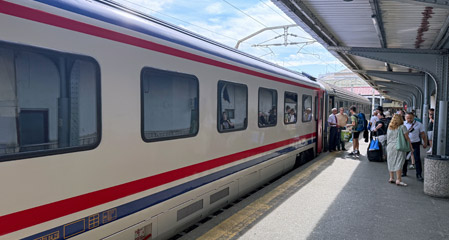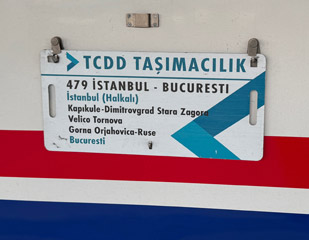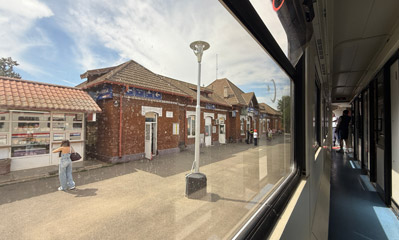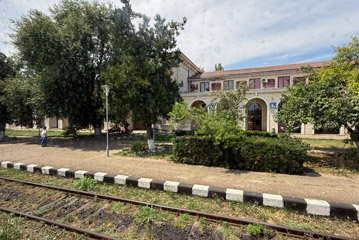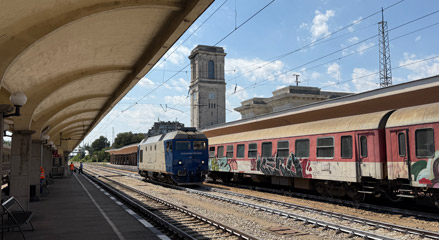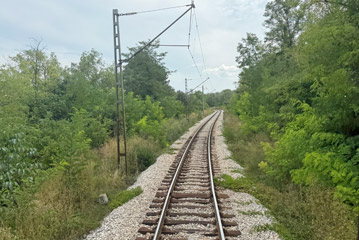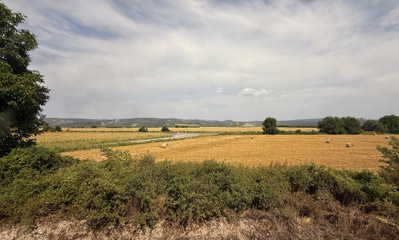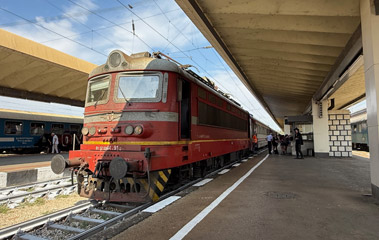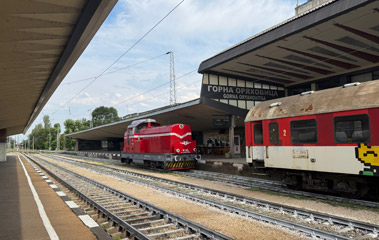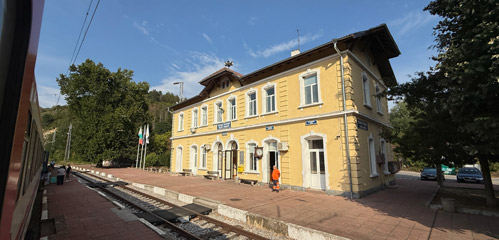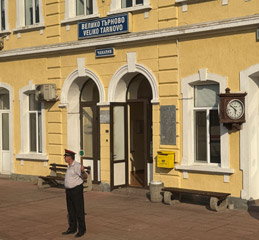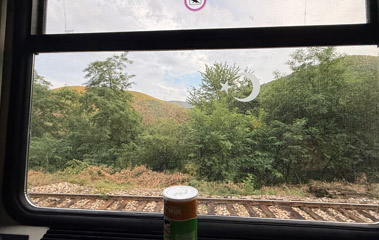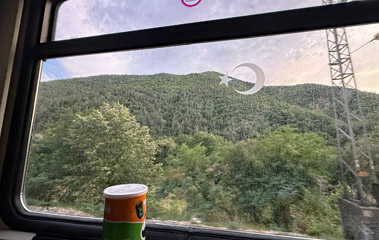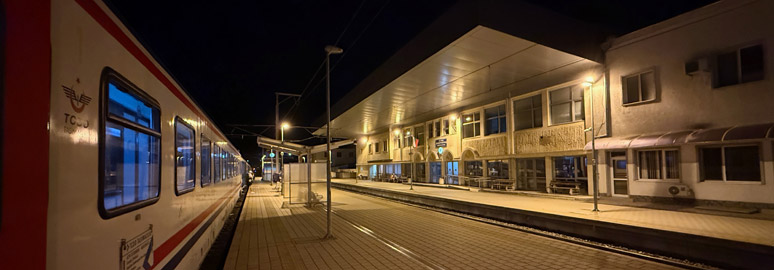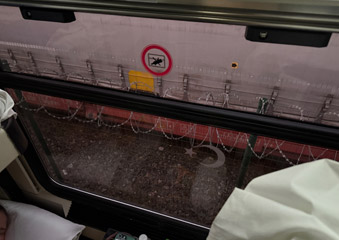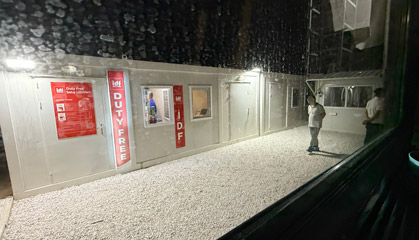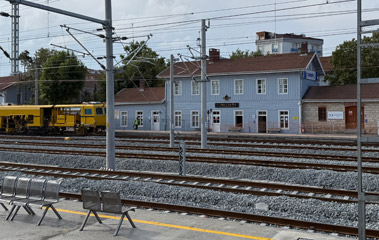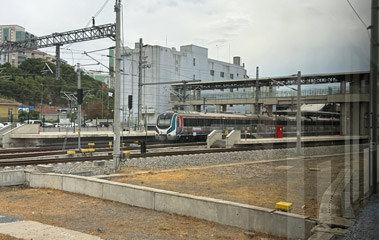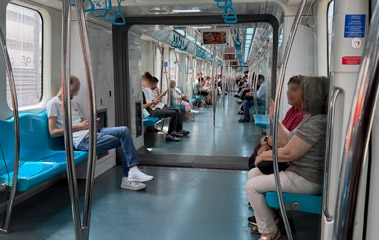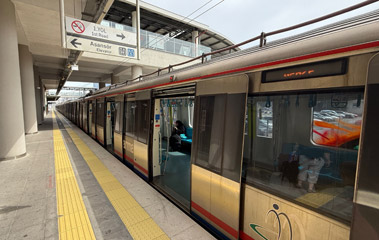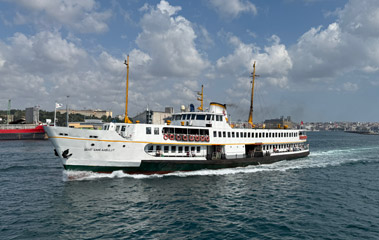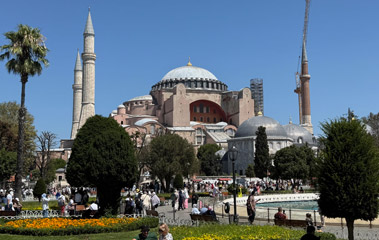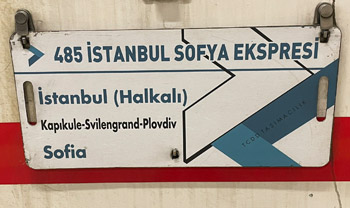 |
|
|
Destination plate on the side of the train (car 483 is one of the sleeping-cars) |
To Istanbul by train
One train per day links Europe with Istanbul, a sleeper train called the Sofia-Istanbul Express. This runs from Sofia to Istanbul every day all year with sleeping-cars & couchettes.
From June until October it conveys a direct couchette car from Bucharest to Istanbul, at other times of year you travel from Bucharest to Dimitrovgrad in Bulgaria on a series of connecting trains where you join the sleepers or couchettes of the Sofia-Istanbul Express to Istanbul.
This page explains train times, fares & how to buy tickets.
Train times eastbound 2026
* = Turkish border formalities should take place at Kapikule, but from August 2025 until further notice it's being done at Edirne, see here.
** = Transfer from Halkali to Sirkeci by frequent Marmaray suburban train as shown here.
*** = Transfer from Sirkeci to Halkali by frequent Marmaray suburban train as shown here.
Train times westbound 2026
How to read this timetable
You read downwards, each column is a separate train. Each train runs every day.
There's a summer & winter service, remember that Bulgaria & Romania put their clocks forward April-October, but Turkey remains on GMT+3 all year.
Sofia-Istanbul is a direct train every day all year round with two sleeping-cars & one couchette car (no seats).
Bucharest-Istanbul is a direct Turkish couchette car from mid-June to early October, attached to each of the trains shown above so there's no need to change. At all other times of year, you travel between Bucharest & Istanbul using seats cars between Bucharest & Dimitrovgrad on each of the trains shown above, then the sleepers or couchettes of the Sofia-Istanbul Express between Dimitrovgrad & Istanbul. Don't worry, it normally all works like clockwork.
The direct couchette car ran Bucharest to Istanbul every day 14 June to 13 October 2025, similar dates expected in 2026.
The direct couchette car ran Istanbul to Bucharest every day 12 June to 11 October 2025, similar dates expected in 2026.
How to check this timetable:
You'll find an accurate timetable in .pdf format at the Bulgarian Railways website www.bdz.bg/en/a/sofia-istanbul-sofia which is what I use to update this page (please let me know if that link stops working). Don't expect timetables to be posted months in advance, for example expect the June-September .pdf timetable to be posted on their website in late May or even early June. You can try checking times at the German Railways website int.bahn.de, but both Bahn.de and the Interrail/Eurail Railplanner app often have incomplete or even incorrect data for this route, for example there is no change of train at Kapikule or at Plovdiv. The train runs direct from Sofia to Halkali via Plovdiv & Dimitrovgrad, exactly as I show above.
Route map
Bucharest to Halkali is 811 km (504 miles). Sofia to Halkali is 605 km (376 miles).
Halkali to Istanbul Sirkeci is 25 km (15.5 miles).
How much does it cost?
-
Sofia to Istanbul
Couchette: 26 for a 2nd class ticket + 10 couchette supplement, paid in local currency.
Bed in a 2 bed sleeper: 26 for a 2nd class ticket + 15 sleeper supplement, paid in local currency.
Single-bed sleeper all to yourself: 40 for a 1st class ticket + 35 sleeper supplement, paid in local currency.
-
Bucharest to Istanbul
The direct couchette car costs 42 for a 2nd class ticket + 14 supplement for a couchette in 4-berth.
When the direct car isn't running: Bucharest to Dimitrovgrad costs around 32. Dimitrovgrad to Istanbul costs around 19 for the basic 2nd class ticket + either 10 for a couchette in a 4-berth compartment or 15 for a bed in a 2-bed sleeper. Sole occupancy of a sleeper costs around 28 for a 1st class ticket + 35 sleeper supplement.
Allegedly Turkish Railways are selling this at 61 + 14 at the station in Istanbul, but it's still 42 + 14 on the Romanian Railways website if you can collect hard copy tickets in Bucharest.
-
The train is priced in euros, but you pay in the local currency. If you have a Eurail or Interrail pass you just need to pay the sleeper or couchette supplement. You need a 1st class pass for a single sleeper.
Check fares from Sofia at www.bdz.bg/en/a/sofia-istanbul-sofia, check fares from Istanbul at www.tcddtasimacilik.gov.tr (use Google translate).
How to buy tickets
The Sofia-Istanbul sleepers & couchettes have become popular and in summer and even autumn the train often leaves fully-booked. I recommend booking in advance if you can, although there's no easy online booking for this route. Read on for advice.
Eastbound, Sofia to Istanbul
-
The Sofia to Istanbul train cannot be booked online.
-
Option 1, email BDZ (Bulgarian Railways) at bdz@bdz.bg, asking to book Sofia to Istanbul, travel date, number of passengers, names and ages, and whether you want single sleepers, double sleepers or couchettes. You collect and pay for tickets at the international ticket windows at Sofia Central when you get to Sofia.
Several seat 61 correspondents have successfully booked this way, but others have been told to book at the station in Sofia. It seems to depend on who handles your email! Maybe try again a few days later if you're refused the first time. Feedback appreciated
-
Option 2, book the Sofia to Istanbul train by emailing Andy on tickets@discoverbyrail.com, the same rail expert that runs www.discoverbyrail.com. Tickets are normally delivered to your hotel in Sofia or a personal handover can sometimes be arranged, ask for details. He can also arrange Interrail or Eurail passholder reservations on these trains for journeys starting in Sofia.
-
Option 3, buy in person at Sofia Central Station at the international ticket windows in the main hall, see the Sofia station page for opening hours. However, the train can get fully-booked, especially in summer.
Eastbound, Bucharest to Istanbul - June-October when the direct couchette car runs
-
Option 1, buy tickets from Bucharest to Istanbul at the Romanian Railways website bileteinternationale.cfrcalatori.ro.
Booking opens 90 days before departure, sometimes later than that at the start of the season in June.
Click EN top right for English. Bucharest is listed as Bucuresti (Romania), for Istanbul you should enter/select Halkali (Turkey).
You must collect hard-copy tickets from the international ticket window at Bucharest Nord or you can choose to collect from another main station in Romania.
It'll book the Bucharest-Istanbul couchette car one-way or round trip in either direction, but only use this method if you can collect hard copy tickets in person in Romania before you travel. You can't collect tickets in Istanbul and can't travel with just a confirmation email. Got it? Good!
Incidentally, if you're coming from Budapest and plan to change onto this train at Videle, Videle is NOT a designated station for ticket collection.
-
Option 2, you can buy tickets for the direct couchette car from Bucharest to Istanbul by emailing Andy on tickets@discoverbyrail.com, see discoverbyrail.com/train-ticket-bucharest-sofia-istanbul. Tickets are normally delivered to your hotel in Bucharest or a personal handover can sometimes be arranged, ask for details. He can also arrange Interrail or Eurail passholder reservations on this train for journeys starting in Bucharest.
-
Option 3, buy in person at Bucharest Nord, from the international ticket window at Bucharest Nord.
Eastbound, Bucharest to Istanbul - at other times of year
-
Step 1, book the train from Bucharest to Ruse (winter timetable) or to Gorna Oryahovitsa (spring/autumn shoulder periods, see the timetable above) using the Romanian Railways international website, bileteinternationale.cfrcalatori.ro.
Booking usually opens 60 days before departure. You print your own ticket or can show it on your phone.
-
Step 2, buy the ticket from Ruse to Dimitrovgrad at the station when you get to Ruse, or (if necessary) from the conductor on board the train.
Alternatively, you can buy a ticket from Ruse to Gorna Oryahovitsa at the Bulgarian Railways website www.bdz.bg, but it won't book as far as Dimitrovgrad. You need to register, tickets can be printed out. Booking opens 30 days before departure. Then buy a ticket from Gorna to Dimitrovgrad when you reach Gorna, or on board the train.
-
Step 3, book a sleeper or couchette from Dimitrovgrad to Istanbul at Gorna Oryahovitsa station, you have enough time between trains to do so, and Gorna ticket office is (obviously) equipped with the Bulgarian Railways ticketing system so can do this. However, the international ticket window may be closed at weekends and holidays.
The train is busy, berths are often available on the day but not always. There is no easy way round this.
Tip: if there are no berths tonight, but berths are available tomorrow, book tomorrow and stop off at Veliko Tarnovo, it's well worth the stop!)
-
Or you can buy in person at Bucharest Nord, from the international ticket window in the booking hall, see the Bucharest Nord station page. In the off-season they can only sell you a ticket as far as Ruse (or at times, Gorna Oryahovitsa), don't worry, buy that, then buy an onward ticket from Ruse or Gorna to Dimitrovgrad at the station when you get to Ruse or Gorna or (if necessary) buy one on the train. When you change trains at Gorna, book the Dimitrovgrad to Istanbul sleeper train at the ticket office there, you have time between trains.
Westbound, Istanbul to Sofia
-
Option 1, you can book from Istanbul to Sofia by contacting Andy on tickets@discoverbyrail.com, see discoverbyrail.com/train-ticket-bucharest-sofia-istanbul. He can arrange sleeper or couchette tickets from Istanbul to Sofia for a fee. Tickets are normally delivered to your hotel in Istanbul, or a personal handover can sometimes be arranged, ask for details. He cannot arrange Interrail or Eurail passholder reservations for westbound journeys from Istanbul as the ticket office need to see your actual pass, a copy is insufficient.
-
Option 2, contact Amber Travel, www.ambertravel.com, a reliable and experienced agency. Their website has a page for ordering Turkish train tickets through them, but they will also arrange international train tickets if you email them.
-
Option 3, buy in person at Istanbul Sirkeci station, see the Istanbul Sirkeci station page.
Westbound, Istanbul to Bucharest - when the direct couchette car runs
-
This train cannot be booked online westbound, unless you will be able to collect hard-copy tickets beforehand somewhere in Romania, in which case you can book at bileteinternationale.cfrcalatori.ro as for the eastbound journey.
-
Option 1, you can book tickets for the direct couchette car from Istanbul to Bucharest by contacting Andy at tickets@discoverbyrail.com, see discoverbyrail.com/train-ticket-bucharest-sofia-istanbul. Tickets are normally delivered to your hotel in Istanbul, or a personal handover can sometimes be arranged, ask for details. He cannot arrange Interrail or Eurail passholder reservations for westbound journeys from Istanbul as the ticket office need to see your actual pass, a copy is insufficient.
-
Option 2, contact Amber Travel, www.ambertravel.com, a reliable and experienced agency. Their website has a page for ordering Turkish domestic train tickets, but they will also arrange international tickets if you email them.
-
Option 3, buy in person at Istanbul Sirkeci station, see the Istanbul Sirkeci station page.
Westbound, Istanbul to Bucharest - at other times of year
-
Step 1, book a sleeper or couchette from Istanbul to Dimitrovgrad.
This cannot be booked online, so contact Amber Travel via www.ambertravel.com, a reliable agency who can arrange this if you email them.
Alternatively, contact Andy on tickets@discoverbyrail.com, see discoverbyrail.com/train-ticket-bucharest-sofia-istanbul. Tickets are normally delivered to your hotel in Istanbul, or a personal handover can sometimes be arranged, ask for details. He cannot arrange Interrail or Eurail passholder reservations for westbound journeys from Istanbul as the ticket office need to see your actual pass, a copy is insufficient.
Or buy in person at Istanbul Sirkeci station, see the Istanbul Sirkeci station page.
-
Step 2, Buy a ticket from Dimitrovgrad to Ruse on board the train from the Bulgarian conductor.
-
Step 3, buy a ticket from Ruse to Bucharest using the Romanian Railways international website, bileteinternationale.cfrcalatori.ro.
Booking usually opens 60 days before departure. You print your own ticket or can show it on your phone.
Or if that fails, buy a ticket from Giurgiu Nord to Bucharest at the Romanian railways domestic website www.cfrcalatori.ro, reports suggest the conductor doesn't care whether your ticket is from Ruse or Giurgiu.
Or simply buy it on board the train from the Romanian conductor ideally in Romanian Lei cash or he may accept card payments.
What's the train like?
Sofia-Istanbul sleeping-cars
The Sofia-Istanbul Express has two Turkish TVS2000 sleeping-cars built in 1998 (car numbers 483 & 484) and can have a 3rd such car at busy times. The car number is indicated on the steel destination plate attached to the side of the car towards one end.
Each sleeping-car is air-conditioned with 10 compartments. Each compartment can be sold as a double (2nd class fare or railpass plus the double sleeper supplement) or single (1st class fare or railpass plus the single sleeper supplement).
Each compartment has an upper & lower berth, sink, table & fridge. Beds are made up with all necessary bedding, soap and towel are provided. Berths fold away to reveal two armchairs for daytime use. There are toilets at each end of the car, western at one end, Turkish at the other. There's a 2-pin power outlet near the sink for electric razors and mobile phones. These cars were built with a shower compartment at one end, but this is now used as a storeroom for bedding. You may be able to buy tea or coffee from the sleeper attendant.
A sleeping-car on the Istanbul-Sofia Express boarding at Halkali. Sleeper interior photos courtesy of @AndyBTravels, DiscoverByRail.com.
Sofia-Istanbul & Bucharest-Istanbul couchette cars
The Sofia-Istanbul Express has one Turkish TVS2000 air-conditioned couchette car built in 1996 or 2002 (car number 485). The direct summer-only couchette car between Bucharest & Istanbul (car 479) is of the same type. The car number is shown on the steel destination plate attached to the side of the car towards one end.
The car has 10 compartments each with 4 berths, two upper, two lower. Sheets, pillow & blanket are provided, you arrange these yourself. The beds fold away to form seats for daytime use as shown below. There are toilets at each end of the car, a western toilet at one end, Turkish hole-in-the-floor at the other, both provided with soap, paper towels and toilet paper. There's a 2-pin power outlet in each compartment above the door to the corridor, but you'll need a 2m cable to use it whilst sitting down with your phone or laptop. Large luggage goes underneath the lower berths, there's rack for smaller items above the window.
The air-conditioning is pretty good, but it may not work in Romania as the Romanian diesel locomotive can't supply the right voltage. You can open the hopper window to get a cool breeze into the car. The air-con should work fine in Bulgaria and Turkey.
The Bucharest to Istanbul couchette car at Gorna Oryahovitsa in Bulgaria.
Bucharest-Istanbul couchette compartment in daytime and night-time modes.
What's the journey like?
The journey from Bucharest to Istanbul is described below. Between June and October you travel in a direct Bucharest-Istanbul couchette car which is coupled to the Sofia-Istanbul Express at Dimitrovgrad. Outside this period you travel from Bucharest to Dimitrovgrad on a series of connecting trains and board the sleeping-cars or couchette car of the Sofia-Istanbul Express there - but it all works like clockwork and you won't be the only person making these connections. The route & scenery are the same.
If you're travelling from Sofia to Istanbul, the journey is as described from Dimitrovgrad onwards.
Bucharest: Above left, boarding the Bucharest-Istanbul couchette car at Bucharest Nord. The couchette attendant checks your reservation at the door to his car. In summer the train consists of just 3 carriages: The air-conditioned Turkish couchette car to Istanbul, an elderly non-air-con Bulgarian car to Sofia (usually covered in graffiti) and a Romanian air-conditioned car to Varna.
Passenger names & passport numbers: If you're travelling in the direct Turkish couchette car, the attendant will come round shortly after departure with a clipboard, to compile a passenger list. He will ask you to write your name and passport number on the list.
Videle (above left): The train heads west and calls at Videle. It then turns south towards the Bulgarian border. Trains have taken the indirect route via Videle since 2005, when a bridge on the direct Bucharest-Giurgiu line collapsed. The line has recently been rebuilt, but only for lightweight local trains, not for heavier locomotives. It remains to be seen if the international train will some day return to the direct line.
Giurgiu Nord, Romanian border (above right): Around 2h30 after leaving Bucharest the train arrives at Giurgiu Nord. Romanian border checks used to be done on board the train here, but since Romania and Bulgaria joined Schengen there are no checks or just a spot check on the train by border police.
The 2.5 km Danube Bridge: Shortly after leaving Giurgiu Nord the train crosses the Danube into Bulgaria over a 2.5 km long steel bridge, the longest steel bridge in Europe, built in 1954 and now also provided with a road deck above the railway.
Ruse, Bulgarian border (above left): Bulgarian border formalities used to be carried out on the train here, but as Romania and Bulgaria are now in Schengen there are usually no checks. At Ruse, the car to Varna is shunted off, and a couple of elderly Bulgarian Ruse-Sofia seats cars are added to the Bucharest-Sofia seats car and Bucharest-Istanbul couchette car. You've time to stretch your legs on the platform, but don't wander far. Above right, there's no catering so bring your own supplies!
The train crosses Bulgaria, it's mainly single track with a lot of clickety-clack on jointed rail and an occasional blast from the locomotive horn.
Gorna Oryahovitsa: Here, the cars to Sofia are uncoupled and depart for the capital. The Bucharest-Istanbul couchette car is shunted out of the station and back in to be coupled to several Bulgarian Gorna-Dimitrovgrad cars. You've time to stretch your legs on the platform here.
Above, watching from the end doors as our Bucharest-Istanbul couchette car is uncoupled from the Bucharest/Ruse-Sofia cars, drawn out of the station then shunted back in onto several Gorna-Dimitrovgrad seats cars waiting in another platform.
Veliko Tarnovo: The train calls at the pretty station at Veliko Tarnovo, the ancient capital of Bulgaria, well worth a 24h stopover! As at most Bulgarian stations, the station master comes out to wave us off.
Scenery in Bulgaria: As evening falls, the train passes hills, mountains and even rocky crags. There is some lovely scenery through this part of Bulgaria, and in one place (if you look at the map) the line spirals around on itself to lose height.
Dimitrovgrad: The train reaches Dimitrovgrad late at night, another chance to stretch your legs on the platform. Shortly afterwards, the Sofia to Istanbul express arrives on the opposite platform. Its locomotive is uncoupled and runs forward, then sets back to pick up the Bucharest-Istanbul couchette car and add it to the front of the three Sofia-Istanbul cars. In the off-season when there's no Bucharest-Istanbul couchette car, you change here onto the Sofia-Istanbul train.
Svilengrad, Bulgarian border (above left)
You know you've reached Svilengrad when you see razor wire outside your window, that's pretty much all you'll see of Svilengrad. Bulgarian border police come on board the train, they collect passports and take them back to their office for processing. They return them to you 20 minutes later. When all checks are complete and all passports have been returned, the train leaves and heads across the border into Turkey.
As you approach the border the train slows and you'll see bright lights and CCTV cameras scanning the train's running gear for illegal migrants.
Edirne, Turkish border (above right)
From August 2025 until further notice, Turkish border formalities are being carried out at Edirne about 20 km inside Turkey, rather than the border station of Kapikule. At Edirne you need to leave the train for border formalities, in both directions. The process is as follows:
Eastbound border process
The train will stop at Edirne's new station. You must get off the train with all your luggage and walk towards the rear of the train to the passport area at the western end of the platform, see the photo above right. First go to one of the two passport windows (visible on the right in the photo above). Place your passport into the drawer under the passport window, the policeman will take it out, stamp it and return it to you. Then go to the X-ray building (just out of shot to the left) to have your bags X-rayed. You can then re-board the train.
Westbound border process
The train will stop at Edirne's new station. You must get off the train, but in this direction you can leave your luggage on board (just take any valuables). Walk towards the front of the train to the passport area at the western end of the platform, see the photo above right. Go to one of the two passport windows (visible on the right in the photo above). Place your passport in the drawer under the passport window, the policeman will take it out, stamp you out of Turkey and return it to you. You can then re-board the train.
Good morning Turkey! Pleasant farmland in the European part of Turkey.
วerkezk๖y (above left): The train makes a brief stop at วerkezk๖y. In 1929 the Orient Express was stuck in snowdrifts near here for 6 days, the event that inspired Agatha Christie's "Murder on the Orient Express".
Halkali (above right): The train rolls into Halkali, that's a Marmaray train into central Istanbul over on platform 1.
Arrival at Istanbul Halkali, on this occasion about 30 minutes late: In years gone by, trains used to make a dramatic entry into Istanbul through the Byzantine Walls of Theodosius, skirting the Sea of Marmara underneath the very walls of the Topkapi Palace into Istanbul's beautiful Sirkeci station, opened in 1890 in the heart of the city. However, this train now terminates at Halkali, a suburban station 26 km (16 miles) west of Sirkeci.
Transfer from Halkali to Sirkeci station in central Istanbul by frequent Marmaray suburban train, as explained here. Map of Istanbul showing stations.
Travel tips
-
Is the overnight train safe?
Yes. In a sleeper or couchette it's comfortable and safe for families, solo females, anyone.
-
Finding & boarding your train
As with virtually all European trains, there's no check-in. Just stroll into the station, find your train and get on, any time before it leaves. The sleeper or couchette attendant will normally greet you on the platform at the door to the sleeping-car and check your reservation. He'll come round and see you soon after departure to take your ticket or pass.
In Bucharest, the train is shown on the departure boards as going to Ruse. In winter train it's train 1095, in summer train IRN 461.
-
Luggage
You take your luggage with you into your sleeper or couchette compartment and simply stick it on the luggage racks above the window, over the door to the corridor, under your seats or on the floor. Nobody weighs it, measures it, or worries about how much you take. More about luggage on European trains.
-
Power outlets & WiFi
In the sleeping-cars, there's a shaver socket in each compartment near the sink aimed at electric razors, but none specifically for laptops or mobiles. In each couchette compartment there's a 2-pin socket above the door to the corridor also aimed at electric razors, you'll need a 2m cable if you want to sit down with your laptop or mobile whilst using it. You may wish to bring a battery pack to keep your phone charged. There's no WiFi, but there is good mobile data reception along the route except in very rural areas.
-
Bring your own food & drink
There's no catering car, so take your own food & drink, even a bottle of wine if you like. The sleeper attendant may be able to sell you tea or coffee.
-
Scenery
The scenery through Bulgaria on the route to or from Bucharest is superb, snaking through Bulgarian river valleys and up (or down) the Shipka Pass.
-
Be ready for border control
You need to get off the train briefly for border control at the Turkish border, read the border control information in the What's the journey like? section above to understand the procedure on both Bulgarian & Turkish side of the border.
-
X-ray bag check at when leaving Halkali: There's a brief baggage X-ray check when accessing the westbound train to Sofia/Bucharest at Halkali, similar to the ones the Turkish Railways do for their YHT high-speed trains.
-
Using an Interrail or Eurail pass
You can use this train with a pass, of course, paying the relevant couchette or sleeper supplement. However, there's a minor irritation when using a pass from Sofia, Bucharest or Dimitrovgrad to Istanbul. You are of course using a direct overnight train so the Interrail night train rule applies and only one pass day (the date of departure) is used. Unfortunately, the Railplanner app incorrectly thinks it's a separate train from Kapikule to Istanbul, therefore if you add it to your pass directly from the Railplanner timetable it will trigger the use of a second pass day to cover what it thinks is a second train leaving after midnight. The solution is to add the Bucharest or Dimitrovgrad to Istanbul train to your pass manually.
-
How to transfer between Halkali & central Istanbul
-
Recommended hotels
in Bucharest, in Sofia and in Istanbul.


